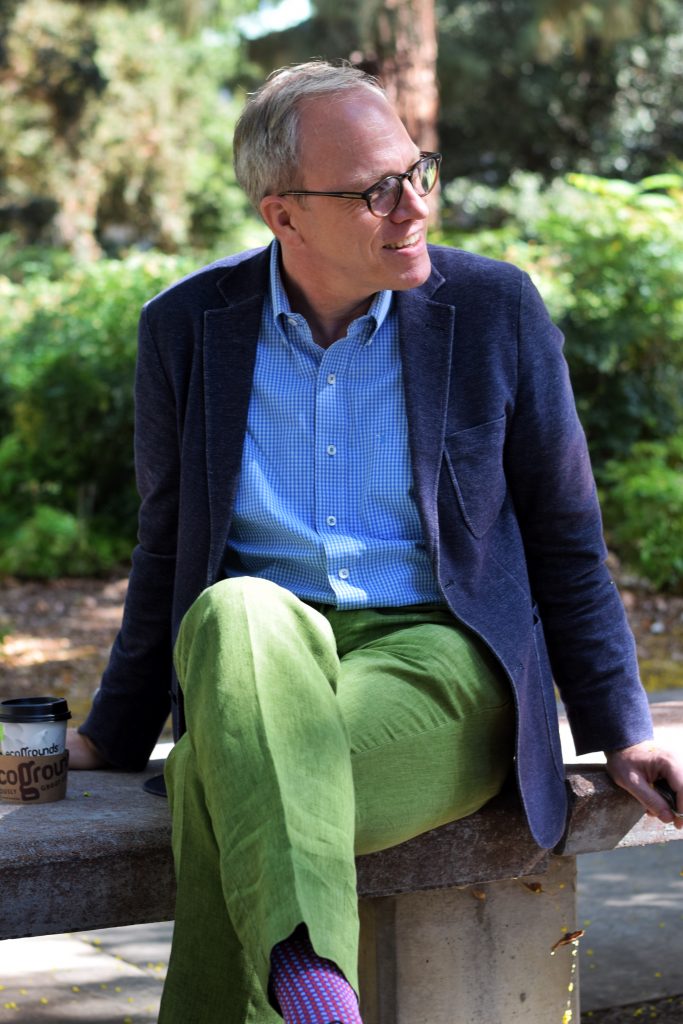 PROFESSOR
PROFESSOR
Dr. phil., Universität Trier; Habilitation/Dr. phil.habil., Universität Leipzig/Germany
(951) 827-1541
johannes.endres@ucr.edu
Academia website
Biography
Johannes Endres joined the departments of Art History and Comparative Literature at UC Riverside in summer 2015. He has received his academic education in Germany, at the Universities of Trier and Leipzig, where he earned his Dr.phil. in 1995, and his Habilitation (Dr.phil.habil.) in 2004, respectively. In the US, he has been teaching as Visiting Professor at the Universities of California in Riverside and Irvine, at San Diego State University, Vanderbilt University, and Cal State Long Beach.
Areas of Specialization
19th Century Art History
German and European Literature 1750-1900 in Interdisciplinary Perspectives (Visual Arts, Film, Music, Sciences)
Cultural Studies
Critical Theory
Important emphases of his research and teaching lie in the area of the history and arts of the ‘long 19th century’, from enlightenment to Weimar Culture and Vienna Moderne. He has published extensively on the intersections of text, visual arts, music, intellectual history, natural sciences, and the history of science. His most recent research projects are dedicated to Friedrich Schlegel, a pivotal figure of German and European intellectualism, and to concepts of fetishism in art, culture, and social studies.
Recent Courses Taught:
AHS 251B
Proseminar in the Historiography of Art History
This seminar examines the historical foundations of art history through readings of its formative texts. The idea is to jump right in to the key debates that have defined our understanding of artworks and visual expression in the Western Tradition from antiquity onward. The course will begin by dissecting core writings on art, aesthetics and meaning by early philosophers and historians. We will then consider how these ideas enabled the codification of art history as a humanistic discipline during the nineteenth century and fueled its further refinement in the early twentieth. Rather than conceptualizing art history as a series of separate and distinct approaches, we will instead trace a few durable concerns that have shaped its practice.
AHS 120 (CPLT 111/EUR120/GER 111/MCS 178)
Berlin Metropolis in Literature, Film, Music, and Art
The course provides an introduction to Berlin and the modern concept of the metropolis as a gateway between the East and West, past and present, private and public life. It explores the topography of the city and the urban space through visual art, film, music, and text. We discuss aspects of city life and its changing expressions in 20th-century culture.
AHS 007
World Art: Images, Issues, Ideas
This course is an introduction to artistic achievements of the world’s cultures and to the ways in which they can be viewed. It provides students with a sound understanding of major art works from all ages and corners of the world, and the theoretical concepts and historical circumstances to which they owe their existence. We ask questions such as: What is art? What is an artist? How has their perception changed over time? What is an image? Why does art exist? What is ‘world art’? Why do we study art history?
Articles
- “Collecting: Defining the Subject,” From Museums to the Internet: Collecting in the Twenty-first Century, co-edited with Christoph Zeller, Rochester (Camden House), 2022, 38-54.
- “Economic Concepts and Authorial Self-Design in Heinrich von Kleist’s Letters,” Heinrich von Kleist: Literary and Philosophical Paradigms, ed. Jeff High, Rebecca Stewart, Elaine Chen, Rochester (Camden House), 2022, 254-286.
-
“Feminisierung und Medialität: Das Beispiel des Briefwechsels Friedrich Schlegels und Friedrich von Hardenbergs (Feminization and Mediality: The Case of Friedrich Schlegel’s and Friedrich von Hardenberg’s Correspondence),” Gestern. Romantik. Heute. Forum für Wissenschaft und Kultur, 2022 (https://www.gestern-romantik-heute.uni-jena.de/wissenschaft/artikel/feminisierung-und-medialitaet-das-beispiel-des-briefwechsels-friedrich-schlegels-und-friedrich-von-hardenbergs-novalis).
- “Eine hermeneutische Dystopie: Das Beispiel der US-Germanistik (A Hermeneutic Dystopia: German Studies in the US),” Zeitschrift für Literaturwissenschaft und Linguistik, vol. 51 (2), 2021, 737-743.
- “Sammeln (Collecting),” Historisches Wörterbuch des Mediengebrauchs, ed. Heiko Christians, Matthias Bickenbach, Nikolaus Wegmann, vol. 3, Köln (Böhlau), 2021, 384-403.
- “Hans Blumenbergs pälaolitische Weltkunstgeschichte (Hans Blumenberg’s Paleolithic World Art History),” New Approaches to Hans Blumenberg, ed. Hannes Bajohr, Eva Geulen, Daniel Weidner, Göttingen (Wallstein), 2021, 313-333.
- “Leonardo’s Childhood Memory: A Textual Analysis,” Vom Wort zur Kunst: Künstlerzeugnisse vom frühen Mittelalter bis zur Gegenwart, ed. Helen Barr et al., Zürich: Edition Imorde, 2021, 190-209
- “Ekphrasis, Visual Description, and Iconic Skepticism in Hans Blumenberg’s Writings,” Describing Cultural Achievements: Hans Blumenberg’s Literary Strategies, ed. T. Attanucci and U. Breuer, Heidelberg: Universitätsverlag Winter, 2020, 111-130
- “Vampires and the Orient in Goethe’s Die Braut von Corinth,” German Quarterly 93/2, 2020, 204-220 (https://onlinelibrary.wiley.com/doi/full/10.1111/gequ.12133)
- “Totemismus und Gesellschaft: Eisenstein über Disney (Totemism and Society: Eisenstein on Disney),“ Scientia Poetica 22, 2018, 83-110 (https://www.degruyter.com/view/journals/scipo/22/1/article-p83.xml)
- “Heterotopian Multilingualism: The Westinghouse Time Capsule (1939),” Critical Multilingualism Studies: An Interdisciplinary Journal, 5/3, 2017, 149-167 (https://cms.arizona.edu/index.php/multilingual/article/view/133/0)
- “Mikrokosmische Autobiografie: Thomas Mann und die Zeitkapsel (Microcosmic Autobiography: Thomas Mann and the Time Capsule),“ Thomas Mann Jahrbuch 30, 2017, 113-131
- “Schlegels Wende zum Bild (Friedrich Schlegel’s Iconic Turn),“ Athenäum: Jahrbuch der Friedrich Schlegel-Gesellschaft 25, 2015, 201-226 (https://brill.com/view/book/edcoll/9783657782697/BP000010.xml)
- “Charakteristiken und Kritiken (Characteristics and Critiques),” Friedrich Schlegel Handbuch: Leben – Werk – Wirkung, ed. Johannes Endres, Stuttgart: J.B. Metzler 2017, 101-140.
- “Über die Sprache und Weisheit der Indier (On the Language and Wisdom of the Indians),” Friedrich Schlegel Handbuch: Leben – Werk – Wirkung, ed. Johannes Endres. Stuttgart: J.B. Metzler 2017, 218-224.
- “Über deutsche Sprache und Literatur (On German Language and Literature),” Friedrich Schlegel Handbuch: Leben – Werk – Wirkung, ed. Johannes Endres, Stuttgart: J.B. Metzler 2017, 235-237.
- “Stockings,” Textile Terms: A Glossary, ed. Anika Reineke, Anne Röhl, Mateusz Kapustka and Tristan Weddigen, Berlin: Gebr. Mann Verlag 2017, 243-247.
- “David Friedrich Strauß und Lessing,” Lessing Yearbook XLII, 2015, 173-193
- “Meaningful Complexity: Goethe’s Concept of Similarity,” Modern Language Notes (MLN) 130/3, 2015, 466-486
- “Die Geburt der Metapher aus dem Selbstmord des Dichters. Zu Hölderlins Empedokles (The Birth of Metaphor from the Poet’s Suicide: On Hölderlin’s Empedocles),” Ökonomie des Opfers. Literatur im Zeichen des Suizids (Morphomata, Bd. 14), Munich 2014, 133-166
- “Zeitkapsel und Paratext (Time Capsule and Paratext),” Verborgen, unsichtbar, unlesbar – zur Problematik restringierter Schriftpräsenz (Workshop SFB 933), New York: de Gruyter 2014, 215-232
- “Notes from the Field: Detail,” The Art Bulletin 94/4, 2012, 481‑485
- “Unähnliche Ähnlichkeit: Zu Analogie, Metapher und Verwandtschaft (Unsimilar Similarity: On Analogy, Metaphor, and Kinship),” Konzepte der Ähnlichkeit in den Künsten (Concepts of Similarity in the Arts), ed. Martin Gaier et al., Munich: Fink, 2012, 29‑58
- “Textures and Cuts. The Textile Metaphor in Jörg Wickram’s The Golden Thread,” Unfolding the Textile Medium in Early Art and Literature, ed. Tristan Weddigen, Berlin: Edition Imorde, 2011, 15‑30
- “Freud und die Komödie der Antike (Freud and Ancient Comedy),”Freud und die Antike (Freud and Antiquity), ed. Claudia Benthien et. al., Göttingen: Wallstein, 2011, 315‑340
- “Si wunder wol gemachet wîp.” Gesicht, Körper und das Paradox der sichtbaren Unsichtbarkeit (Face, Body, and the Paradox of Visibile Invisibility),” Zeitschrift für Kunstgeschichte 2009, 297‑312
- “Evolution und Erbe. Zur Problemgeschichte der ‘Wahlverwandtschaften’ bei Goethe und Darwin (Evolution and Legacy. ‘Elective Affinities’ in Goethe and Darwin),” KulturPoetik 9, 2009, 45–66
- ” ‘I can see something you don’t see,’ or: There is no Alternative to the Culture of Arguments,” Journal for Literary Theory (JLT) 2, 2008, 157-166
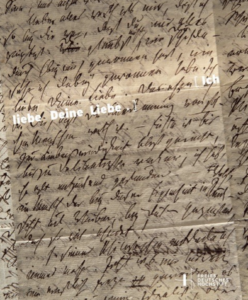 Ich liebe Deine Liebe. Der Briefwechsel zwischen Friedrich Schlegel und Friedrich von Hardenberg (Novalis). Eine Ausstellung im Deutschen Romantik-Museum, 26. April -28. August 2022. Katalog
Ich liebe Deine Liebe. Der Briefwechsel zwischen Friedrich Schlegel und Friedrich von Hardenberg (Novalis). Eine Ausstellung im Deutschen Romantik-Museum, 26. April -28. August 2022. Katalog
(The Correspondence of Friedrich Schlegel and Friedrich von Hardenberg. An Exhibition at the German Museum for Romanticism, Catalogue)
2022, Frankfurt/Main: Freies Deutsches Hochstift
“I love your love”, writes Friedrich Schlegel in 1797 to his friend Friedrich von Hardenberg, known later also as “Novalis”. That is a new and unheard-of tone for a correspondence, even for a literary correspondence among poets. What had happened that made such a tone possible? The catalogue that accompanies the exhibition of Schlegel’s and Hardenberg’s epistolary manuscripts at the new German Romanticism Museum in Frankfurt attempts to answer that question by foregrounding the cultural and intellectual dimension of the relationship between both men and the friendship circle around them.
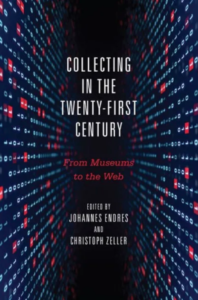 From Museums to the Internet: Collecting in the Twenty-First Century
From Museums to the Internet: Collecting in the Twenty-First CenturySeminal to the rise of human cultures, the practice of collecting is an expression of individual and societal self-understanding. Through collections, cultures learn and grow. The introduction of digital technology has accelerated this process and at the same time changed how, what, and whywe collect. Ever-expanding storage capacities and the accumulation of unprecedented amounts of data are part of a highly complex information economy in which collecting has become even more important for the formation of the past, present, and future. Museums, libraries, and archives have adapted to the requirements of a digital environment, as has anyone who browses the internet and stores information on hard drives or cloud servers. In turn, companies follow the digital footprint we leave behind. Today, collecting includes not only physical objects but also the binary code that allows for their virtual representation on screen. Collecting in the Twenty-First Centuryidentifies the impact of technology, both new and old, on the cultural practice of collecting as well as the challenges and opportunities of collecting in the digital era. Scholars from German Studies, Media Studies, Museum Studies, Sound Studies, Information Technology, and Art History as well as librarians and preservationists offer insights into the most recent developments in collecting practices.
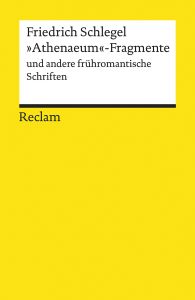
Friedrich Schlegel: “Athenaeum“-Fragmente und andere frühromantische Schriften (“Athenaeum“ Fragments and Other Early Romantic Writings: Edition, Commentary and Epilogue)
2018, Stuttgart: Reclams Universal Bibliothek
Friedrich Schlegel’s critical writings on literature and art played a central role in the emergence of European romanticism as an intellectual movement. The book assembles and annotates the most important of Schlegel’s texts, prior to his conservative turn in 1808. In addition to the texts, which the edition presents according to their first prints (undoing modifications and modernizations previous editions have introduced), the volume also provides extensive explanations of Schlegel’s language and the many references he makes. The epilogue sheds light on the various complexities of Schlegel’s thinking and, following the concept of the Reclam Universal Library, renders it accessible to a wider audience.
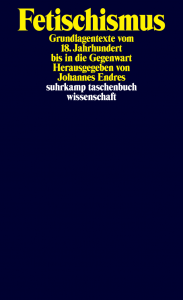 Fetischismus: Grundlagentexte vom 18. Jahrhundert bis in die Gegenwart (Fetishism: Source Texts from the 18th century to the present).
Fetischismus: Grundlagentexte vom 18. Jahrhundert bis in die Gegenwart (Fetishism: Source Texts from the 18th century to the present).
2017, Suhrkamp Verlag (Taschenbuch Wissenschaft): Frankfurt M.
This volume brings together key contributions from the history of fetishism as a cultural practice, discourse and concept. Texts gathered here stem from a variety of fields and disciplines, including ethnography, anthropology, religious history, sociology, the critique of commodification and consumerism, psychoanalysis, gender studies, aesthetics, semiotics and epistemology. These texts, and their selection and presentation in this book, are concerned with a number of questions, which are crucial to the history of fetishism since the 18th century up to the present: Which forces regulate peoples’ relationships to their favorite things? Does the veneration of a piece of clothing repeat an archaic disposition from a remote religious past? Is the commodity fetish a descendant of the idols of the so-called indigenous peoples? Or is the existence of the fetish only owed to the derogatory and misconstrued views of an opaque and alien ‘other’ (the ‘primitive’ people, the childish mind, the bourgeois economy, the pervert)? All texts are carefully introduced and linked to each other through commentaries by the editor, which outline major trajectories of one of the oldest fascinations of humankind – that with the seemingly meaningful objects that it surrounds itself with.
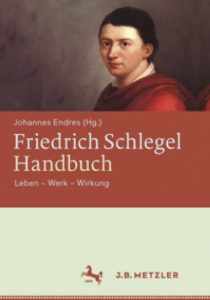 Friedrich Schlegel Handbuch: Leben – Werk – Wirkung (Friedrich Schlegel Handbook: Life – Work – Reception)
Friedrich Schlegel Handbuch: Leben – Werk – Wirkung (Friedrich Schlegel Handbook: Life – Work – Reception)
2017, J.B. METZLER: STUTTGART
Friedrich Schlegel’s life career, from his revolutionary youth over the Jena years up to his catholic conversion, serves as a mirror of the Romantic era as a whole. His theoretical writings laid the groundwork for the idea of Romantic poetry as a “progressive universal poetry”; his historical-critical method helped to establish ‘Literaturwissenschaft’ (literary studies) in the way it is still practiced today. This handbook presents Schlegel’s oeuvre in its entirety, covering, besides his literary and aesthetic writings, his texts and fragments on classical studies, philosophy, the history of European and world literature, history and politics, and art history, including his many-faceted activities as editor, journalist, and prolific letter writer. Additional chapters address terms and ideas pivotal to his work at large, such as Fragment, Irony, Wit (“Witz”), Mythology, Revolution, and Incomprehensibility. The book, which features contributions from internationally recognized Schlegel and Romanticism scholars, is the first comprehensive reference work on one of the most influential spearheads of European intellectual history.
 Literatur und Fetischismus: Das Bild des Schleiers zwischen Aufklärung und Moderne (Literature and Fetishism: The Veil-Motif from Enlightenment to Modernity)
Literatur und Fetischismus: Das Bild des Schleiers zwischen Aufklärung und Moderne (Literature and Fetishism: The Veil-Motif from Enlightenment to Modernity)
2014, FINK: MUNICH
European eighteenth-century discourse saw the advent of two concepts, which have been central to our understanding of man’s relationship to the world and himself ever since: the proclamation of the autonomous artwork and the stigmatization of un-enlightened attitudes towards reality as ›fetishistic‹. The book argues that this is not a coincidence. Thus, it explores the discourse on and the phenomenon of fetishism in its major historical manifestations in ethnology, religious philosophy, social and economic theory, and finally psychoanalysis from the eighteenth to the twentieth century. Particular interest is paid to the metaphorical transfer of the veil motif between images and text, including the comparison of both media in the history of aesthetics from Lessing over Kant, Hegel and Nietzsche up to Benjamin and Warburg. The history of modern art thus appears as a revision of a teleology that implies an evolutionary escape of man from its fetishistic beginnings.
 Codes of Passion: Fetishims in the Arts
Codes of Passion: Fetishims in the Arts2010, FINK: MUNICH
The book contains contributions from scholars from literary, visual and media studies, history, the social sciences, philosophy, anthropology, psychoanalysis, and fashion history. It is the first to focus on the role of fetishism in the arts and their relevance for the discourse on fetishism. Fetishism is a key phenomenon of modern societies. It not only influences religious and mental dispositions but also libidinous object relations in consumerism and mass culture. The contributions thus focus on fetishism as a cultural ‘index fossil’ and pursue its traces into the fields of force between artists, works, collections, art reception, and beyond. In doing so, the book traces back present cultures of fetishism in art, media, and economy to the origin of fetishism as an intercultural and colonialist concept in the 18th century.
 Iconology of Interspace: The Veil as Medium and Metaphor
Iconology of Interspace: The Veil as Medium and Metaphor
2005, FINK: MUNICH
This volume gathers the proceedings of the conference “Veil: Image, Text, Ritual”, co-organized with Gerhard Wolf at the University of Trier in 2001. Its contributions discuss the veil as an artistic motif, a literary metaphor and an episteme in aesthetics, ethnology, anthropology, philosophy, social and political sciences. Both conference and book brought together specialist from various fields to explore the changes and continuities of representations of the veil. The contributions are tied together by conceptual essays from the editors, which highlight overarching aspects such as textures of opacity, allegories of seeing and reading, thresholds between media, and specters and their garments‹. Conference and book realize a fruitful collaboration between academics from literary history, art history, philosophy, and beyond.
 The “Disempowered” Subject: On the History and Function of Comedy in Heinrich von Kleist’s Works
The “Disempowered” Subject: On the History and Function of Comedy in Heinrich von Kleist’s Works
1996, Königshausen & Neumann: WÜRZBURG
Kleist scholars tend to imagine the author as the paradigmatic exponent of a tragic mind. The shadows of his tragedies in life and literature seem too heavy and gloomy to leave room for comic tendencies. Although Kleist’s two comedies have always been acknowledged as true highlights in the history of the genre, his comic “strategies” – as well as their precedents from Lessing to Freud – have mostly been ignored. However, with such strategies in mind, the author’s situation appears as one in which the demands of an idealist worldview provoke a retreat to the limited and reduced formats of comedy. Kleist’s massive ‘struggle with Schiller’ – his predominant role model and antipode – is here reexamined in the light of a general struggle to avoid tragic inevitabilities.
